Civilian Conservation Corps Camp SP-1: North Park
Introduction
Author-Uploaded Audio
00:00 / 00:00
CCC Introduction Audio
Text-to-speech Audio
On June 16, 1933 a group of 175 young men set up camp on the hillside above Wildwood Road, thus establishing Civilian Conservation Corps (CCC) Camp SP-1. The CCC spent over two years improving North Park, up until October 1, 1935 when the final enrollees were transferred to another site. Though nothing of their camp remains here the legacy of their work can be seen all across North Park.
Images
CCC Camp S.P.-1 on October 23, 1933

CCC Camp S.P.-1 - Co. 1383, Staff and Enrollees on May 19, 1934
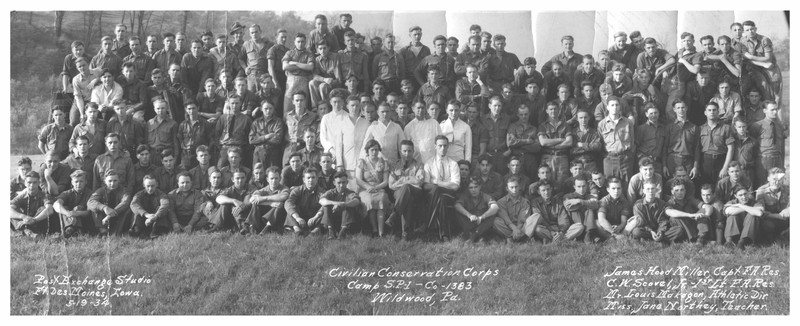
View of Civilian Conservation Corps Camp S.P.-1 - Co. 1383, Wildwood, Pa. on May 19, 1934
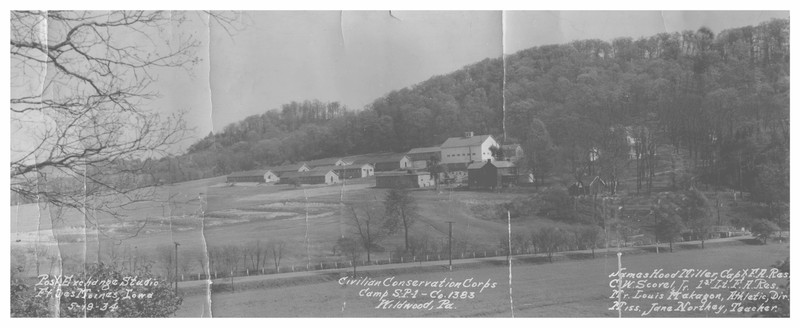
CCC workers performing tree work in North Park on October 23, 1933
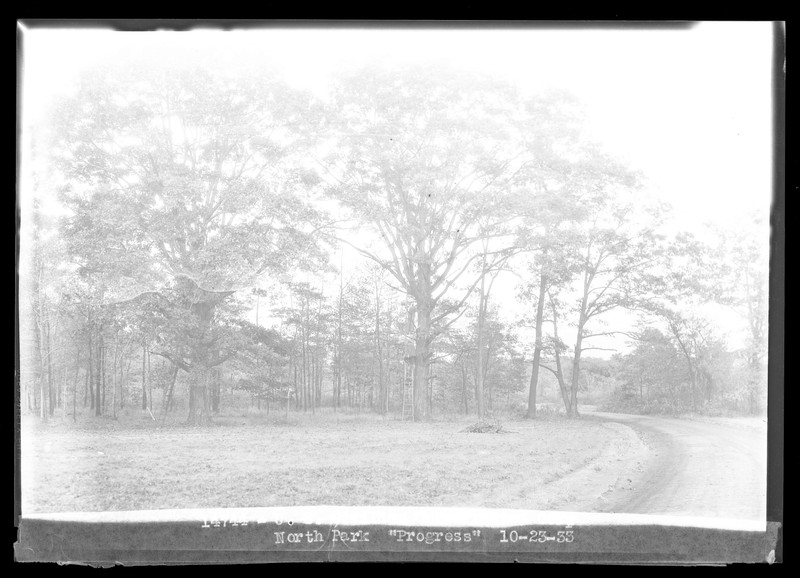
CCC workers milling logs in North Park on October 23, 1933
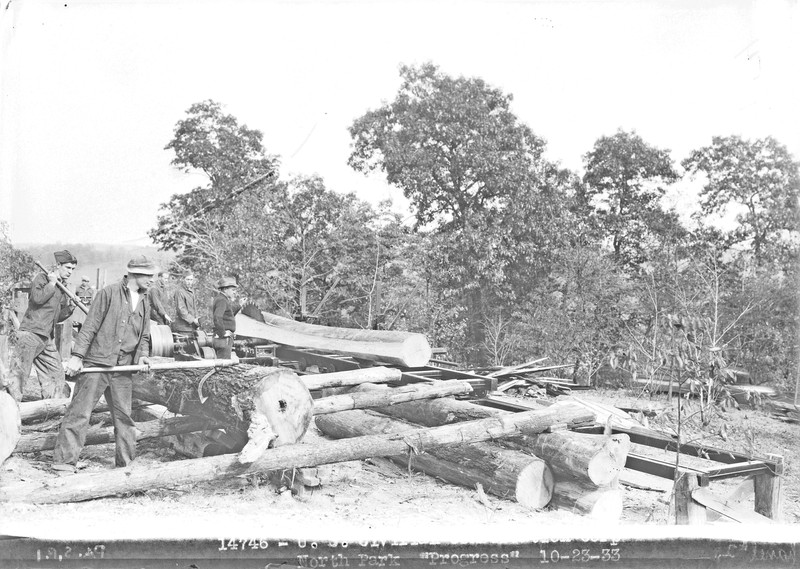
CCC workers using hand tools to perform work on South Ridge Drive
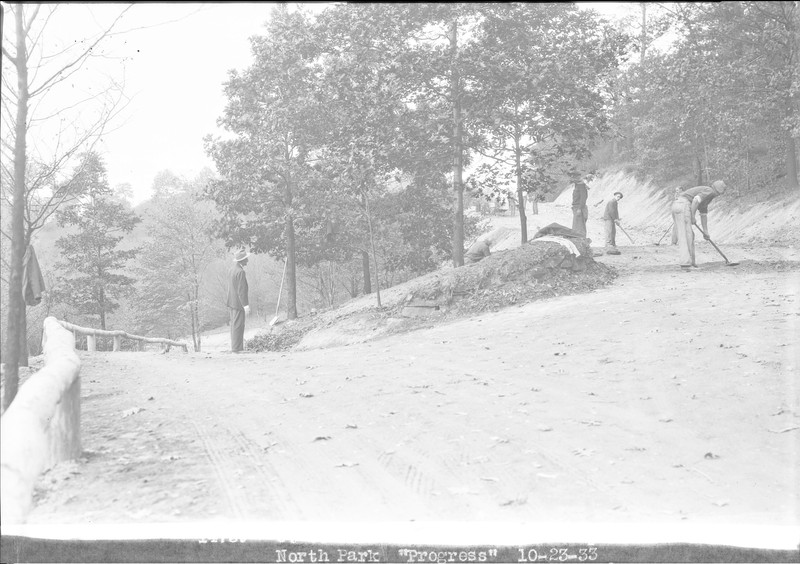
Backstory and Context
Author-Uploaded Audio
00:00 / 00:00
Listen to a narration of this entry's description by Deaglan McManus.
Text-to-speech Audio
In his second Fireside Chat President Roosevelt said “In creating this civilian conservation corps we are killing two birds with one stone. We are clearly enhancing the value of our natural resources and at the same time we are relieving an appreciable amount of actual distress.”1 The CCC was a voluntary program that first opened to enrollees in the spring of 1933. The earliest enrollees were required to be unemployed, unmarried, male citizens between the ages of 18 and 25. They committed to six months of work at a time, and were paid a starting wage of $30 a month. Though they were required to send most of their pay back home to support their families, the men were fed, clothed, and housed while enrolled in the CCC. Over the next nine years the CCC employed over two million men on forestry and conservation projects, the value of which has been estimated to be $8 billion. Pennsylvania had more CCC camps than any other state besides California. Two of these camps, SP-1 and SP-3, were in Allegheny County’s North and South Parks, respectively.
Camp SP-1 in North Park opened on June 16, 1933 when Company 1383, comprised of 175 enrollees from Allegheny County families, arrived to the site on Wildwood Road in the pouring rain. Their first day was spent setting up their tents, which fit five men each, and served as their temporary accommodations until they could construct their larger barracks at a later date. Close to 200 enrollees would eventually call the camp home, working alongside local men on projects across the park. Among the earliest members of Co. 1383 was Bloomfield resident Nick Ranalli, who joined shortly after leaving Schenley High School. Ranalli arrived a few weeks after the camp opened and served for three terms, a total of 18 months, helping to establish North Park. His first three months were spent reforesting the park, the next five months he helped to clear brush for future trails, and his final five months he helped build fire pits and shelters.2 On October 1, 1935, less than a month after Ranalli’s honorable discharge, the North Park CCC Camp closed when the remaining members of Co. 1383 were transferred to Camp SCS-2 in Sprankle Mills, PA.
The work of the CCC was praised by Parks Director A.M. Marion in both the 1933 and 1934 Annual Reports.
In 1933 he wrote “There existed in North Park a large area of undeveloped woodlands which properly developed with roads, trails, bridle paths and groves would be useful for various purposes. This work could not have been done by normal County labor, as with the present Park mileage tax, it is barely sufficient for maintenance. Under the CCC this area of woodland known as the “Henderson” tract which comprises approximately 500 acres above the Babcock Boulevard, has been opened for Park use.” The detailed list of work the CCC under took in the first six months included clearing wooded areas of fire hazards in order to establish picnic groves, building three miles of dirt roads to access such areas, constructing six miles of foot and horse trails, and milling diseased or dead trees for lumber and firewood. The report ends with Marion saying “There can be no doubt as to the Benefit North Park has derived from the Civilian Conservation Corps. The boys of the camp are to be commended for their effort and the work which they have achieved.”3
In 1934 Director Marion’s accolades continued, stating “The economic value of the Civilian Conservation Corps, of which there is a camp in each Park, is immeasurable. The work done by these forces has advanced the ordinary development of each Park by several years. A brief summary of some of the work accomplished by this organization is cited below: In the two Parks they constructed 14.3 miles of Bridle Trail Fords, 10.9 miles of Roads, 8 miles of Firebreaks, 176 Catch Basins on roads and trails; installed 5,014 feet of pipe for road drainage; cleared 248 acres for picnic groves, 130 acres eradicated of insect infection, 370 acres of woodland cleaned up, dead and diseased trees removed, 365 acres planted with seedlings; 114 stone ovens and 39 shelters constructed in groves, 12,975 feet of guard rail built, 13 foot bridges erected, 16 latrines built and 600 feet of vitrified pipe installed on erosion control. Four water wells were drilled and 6,842 feet of water line laid to new groves. They also sawed about 300,000 feet of boards and timbers from logs removed from the woodlands, all of which were used in the Parks."4
When the CCC left SP-3 in South Park, 58 men from SP-1 in North Park were transported the 50 miles daily in order to demolish the camp buildings there. SP-3 closed in late April of 1935, when Company 1301 was transferred to the first Soil Conservation Service camp in Pennsylvania, located in Indiana Township. By September of that year the North Park CCC had demolished “1 Administration Building, 5 Barracks Buildings, 3 Garages, (14 Stalls), 1 Recreation Hall, 1 Wash Room”, noting in a report to the National Park Service that “1 Mess Hall and 1 Latrine remain to be razed.”5
In addition to the training the CCC men received while performing various tasks in the parks, they were also provided with educational opportunities in the evening. One night a week transportation was provided to Pittsburgh’s Washington and Arsenal Schools in Lawrenceville to attend business and vocational classes. According to the official camp report filed on November 1, 1934, 73 of the enrollees took advantage of that off-site opportunity. Only one man was considered illiterate, and he was attending school at the camp. A teacher was supplied by another New Deal program, the Federal Emergency Relief Administration (FERA), held classes each weekday evening from 4-10pm, with an hour break for dinner. Each enrollee was taking at least one class, which were offered “on practically all academic subjects starting with the very elementary subjects.”6 The staff photo taken on May 19, 1934 shows the only woman at the center of the photo, and lists her as teacher Miss Jane Northey. Miss Northey was later replaced by Miss Mary J. Stephenson, who is listed in the November 1934 camp report as the teacher.
Women were intentionally barred from serving in the CCC throughout its history. Thanks to First Lady Eleanor Roosevelt, with the support of Secretary of Labor Frances Perkins, an alternative to the CCC was created for unemployed women. Camp Tera, the first site of what critics called the She-She-She, opened in upstate New York only six days before SP-1 was established. The closest camps for women were in Warren, PA, Morgantown, WV, and Oberlin, Ohio. It is unknown at this time how many Allegheny County residents were enrolled in these programs.
As Pauli Murray, an early enrollee at Camp Tera, wrote in their 1987 autobiography: “It was little more than a recreational camp for adult women at the time I was there, since it offered no work experience beyond our camp duties and was only one step removed from the dole. Yet for me, as for most other women in the camp, it provided a sanctuary from the pressures of unemployed city life. It was our first experience of outdoor camp life that we had missed as children. And thanks to an enlightened social policy, it was unsegregated...”7 The camps were discontinued in 1937, after aiding 8,000 enrollees across 90 sites.
The bill establishing the CCC explicitly forbid racial discrimination, thanks to an amendment by the only Black congressman at the time Oscar De Priest (R-Illinois). At the time segregation was not considered discrimination under the law, and almost all CCC Camps were segregated. Of Pennsylvania’s 151 CCC Camps, only a dozen were designated for Black enrollees. The official Camp Reports from both December 14, 1933 and November 1, 1934 indicate that North Park’s SP-1 was designated as a white camp. One of the closest CCC Camps to North Park for Black enrollees was SP-11 at Pymatuning State Park. Records indicate that at least 32 of the members of Company 2312-C located there in 1936 were from Allegheny County. When Pittsburgh faced its worst flood in history that March, Co. 2312 helped in the rescue efforts both in Pittsburgh and in Johnstown.
The CCC served as a model for what would become the Student Conservation Association (SCA), an idea conceived in 1953 by Liz Putnam to enlist “student volunteers to assist with the upkeep of U.S. national parks and public spaces.”8 The SCA, integrated since its founding, continues to provide service opportunities across the nation. That includes right here in North Park where the SCA has trained trail crews, and employed the seasonal Park Rangers from 2015-2017. As of 2018, more SCA alums live in Pittsburgh than any other city in the nation.
Though there is no visible trace of CCC Camp SP-1 on this site, their work is still present all across our park. The former camp site off Wildwood Road is now home to the Allegheny County Department of Public Works District #1 Warehouse, Sign Shop, and Traffic Division. Directly below the site sits the McCandless Township Sanitary Authority Pine Creek Sewage Treatment Plant, constructed between 1973 and 1975.
Cite This Entry
Deaglan McManus on behalf of Allegheny County Park Rangers and Deaglan McManus. "Civilian Conservation Corps Camp SP-1: North Park." Clio: Your Guide to History. February 14, 2022. Accessed April 17, 2025. https://theclio.com/entry/141657
Sources
Footnotes
- Franklin D. Roosevelt, “Fireside Chat 2: On Progress During the First Two Months,” recorded May 7, 1933, https://millercenter.org/the-presidency/presidential-speeches/may-7-1933-fireside-chat-2-progress-during-first-two-months.
- Dennis N. Ranalli, Mary Bates, and Amy Steele, “The Civilian Conservation Corps in Pittsburgh: Transforming a Camp Into a Park, Western Pennsylvania History Magazine, Winter 2019-20, 32-34.
- A.M. Marion, “Department of Parks and Aviation”, in 1933 Annual Report of Allegheny County (Pittsburgh: Board of County Commissioners, 1934), 565-566.
- A.M. Marion, “Department of Parks and Aviation”, in 1934 Annual Report of Allegheny County (Pittsburgh: Board of County Commissioners, 1935), 416.
- E.F. Flynn, “Narrative Report For Period August and September 1935,” United States Department of the Interior, National Archives Record Group 35, National Archives at College Park, MD.
- Charles H. Kenlan, “Camp Report Day Ending Nov. 1, 1934,” (Emergency Conservation Work, Office of the Director, Washington, D.C.), Records of the Civilian Conservation Corps, Record Group 35, National Archives at College Park, MD.
- Pauli Murray, Song in a Weary Throat: An American Pilgrimage (New York: Harper & Row, 1987), 95-96.
- “Liz Putnam, SCA Founder,” About, Student Conservation Association, accessed November 15, 2021, https://www.thesca.org/about/sca-founder-liz-putnam.
Additional Sources
“Forest Army Unit Marches on North Park,” Pittsburgh Post-Gazette, June 17, 1933, https://www.newspapers.com/image/89889647.
“History of Company 1301." In 1936 Annual: Civilian Conservation Corps, 75. District No. 2 Third Corps Area, U.S.A., 1936. http://www.justinmuseum.com/jfjmuseum/1936annual.html.
"History of Company 1383.” In 1936 Annual: Civilian Conservation Corps, 81. District No. 2 Third Corps Area, U.S.A., 1936. http://www.justinmuseum.com/jfjmuseum/1936annual.html.
“History of Company 2312." In 1936 Annual: Civilian Conservation Corps, 75. District No. 2 Third Corps Area, U.S.A., 1936. http://www.justinmuseum.com/jfjmuseum/1936annual.html.
Kenlan, Charles H. “Camp Report Day Ending Dec. 14, 1933.” Emergency Conservation Work, Office of the Director, Washington, D.C. Records of the Civilian Conservation Corps, Record Group 35. National Archives at College Park, MD.
Kenlan, Charles H. “Camp Report Day Ending Nov. 1, 1934.” Emergency Conservation Work, Office of the Director, Washington, D.C. Records of the Civilian Conservation Corps, Record Group 35. National Archives at College Park, MD.
Lacy, Leslie Alexander. The Soil Soldiers: The Civilian Conservation Corps in the Great Depression. Radnor, PA: Chilton Book Company, 1976.
McCandless Township Sanitary Authority. "Pine Creek Sewage Treatment Plant." Accessed November 10, 2021. https://www.mtsaonline.org/index.asp?SEC=1F32844B-5A2A-4FC5-B4EB-27AA2711B6B6&DE=A32EB1B4-414C-4219-8E55-F008DD6D0E94&Type=B_BASIC.
Pennsylvania Department of Conservation and Natural Resources. “CCC Years.” History. Accessed November 14, 2021. https://www.dcnr.pa.gov/StateParks/History/CCCYears/Pages/default.aspx.
“Roster Company 2312." In 1936 Annual: Civilian Conservation Corps, 77. District No. 2 Third Corps Area, U.S.A., 1936. http://www.justinmuseum.com/jfjmuseum/1936annual.html.
"Soil Erosion Camp Making Fine Progress." The Jeffersonian-Democrat (Brookville, PA), April 16th 1936. https://www.newspapers.com/image/302626158.
Allegheny County Photographers, 164741 - U.S. Civilian Conservation Corp North Park "Progress", October 23, 1933, negative, Detre Library and Archives, Sen. John Heinz History Center.
Pennsylvania CCC Online Archive Photos
Pennsylvania CCC Online Archive Photos
Allegheny County Photographers, 14744 - U.S. Civilian Conservation Corp North Park "Progress", October 23, 1933, negative, Detre Library and Archives, Sen. John Heinz History Center.
Allegheny County Photographers, 14746 - U.S. Civilian Conservation Corp North Park "Progress", October 23, 1933, negative, Detre Library and Archives, Sen. John Heinz History Center.
Allegheny County Photographers, 14739 - U.S. Civilian Conservation Corp North Park "Progress", October 23, 1933, negative, Detre Library and Archives, Sen. John Heinz History Center.

